This week we introduce you to the Negro League Centennial Team (1920 – 2020) which consists of 30 of the greatest African-American and Cuban players from 1895 – 1947.
First up and released this month is Hilton Smith, shown as a member of the KC Monarchs.

From nlbemuseum.com (http://www.nlbemuseum.com/history/players/smithh.html)
A teammate of Satchel Paige on the Kansas City Monarchs, he was best known for being "Satchel's relief." After Satchel pitched 3 innings, Smith would come in and pitch the last 6 innings, with no appreciable difference in effectiveness. In October 1941, Bob Feller regarded him as even better than Paige. Yet because Smith's quietness contrasted with Satchel's flamboyance, Smith never received the publicity that Satchel attracted in abundance.
Possessing the best curveball in black baseball, many thought that Smith was the best all-around pitcher in the game. In addition to his superlative curves, he had a high, hard fastball that "took off," a sinker, a slider, and a change of pace, all of which he threw both sidearm or overhand, maintaining good control with both styles of delivery.
Smith began playing town ball with his father, a teacher by profession, in 1927, and continued his baseball when he attended Prairie View A&M College in Texas for two years. During his last season there, he began pitching, and afterward played semi-pro ball with the Austin Senators in 1931. The next season, as a 20- year old, he joined the Monarchs of Monroe, Louisiana, who were members of the Negro Southern League. In 1932 the league was recognized as a major league because of the influx of players from the defunct Negro National League. For the next three years he played with teams of lesser quality, including the New Orleans Crescent Stars, and pitched in the National Baseball Congress in Wichita in 1935 36, registering a perfect 5-0 slate, indicating that he was ready to step up to the black major leagues. In the fall of 1936 he began barnstorming with the Kansas City Monarchs, who became charter members of the Negro American League in 1937, and he became a mainstay with the franchise until his retirement after the 1948 season.

During his twelve years with the Monarchs, playing against all competition, the right-handed hurler won 20 or more games each year, pitched a no hitter in 1937, and reportedly did not lose a league game in 1938. Over a six year period he compiled a 129-28 ledger, with his best years coming in 1939-1942, when he was credited with records of 25-2, 21-3, 25-1, and 22-5 against all opposition. In 1941 he is credited with a perfect 10-0 league ledger, suffering his loss in a non-league contest. Also pitching two winters in Cuba during the late 1930s, the native Texan compiled a 10-5 record on the island. A good hitter, Hilton often pinch-hit and played first base or in the outfield.
The Monarchs' ace pitched in six consecutive All Star games, 1937-1942, striking out 13 batters, tying with Satchel Paige for second place on the all-time All Star list, only one strikeout behind Leon Day. Smith was the winning pitcher in the 1938 contest, and his All Star years coincided with the years of the Monarchs' domination in the Negro American League, a period during which they won five pennants in the first six years of the league's existence.
The last of these, 1942, was the year that the first Negro World Series was played between the Negro American League and the more established Negro National League. Smith pitched in this Series and again in the 1946 World Series, starting once in 1942 and twice in 1946 and winning a game in each Series for a composite 2-0 World Series record with a 1.29 ERA.

In 1943 Smith suffered an injury to his pitching arm, dropping to a .500 mark and splitting 8 league decisions for the war-weakened Monarchs, but the keen competitor bounced back in 1944 with a 2.74 ERA while turning in several one-hit gems and being credited with 8 strikeouts per game but managing only a 2-5 record in league contests. The next season the dependable hurler registered a 5-3 league ledger with a 2.31 ERA and, with many regulars lost to military service, the Monarchs sometimes utilized him as an outfielder, first baseman, or pinch-hitter to take advantage of his batting skills.
His averages validate his ability with a bat, as he registered marks of .360 in 1942 and .333, .243, and .431 in 1944-1946. In his assignments as an everyday player, his overall play was adequate, as he demonstrated an outstanding throwing arm and his hustle afield compensated for a lack of speed and other defensive deficiencies. In 1946, with the regulars back in the lineup after the War, he fashioned an 8-2 record to help pitch the Monarchs to the 1946 pennant.
That winter he pitched in Venezuela and fashioned an 8-5 record for the champion Vargas ballclub. In March, after the end of the winter season, he pitched for Vargas against the New York Black Yankees in Venezuela, and allowed the Yankees only 1 hit in 5 innings to earn the win in a 4-3 victory. With Jackie Robinson beginning his first spring with the Brooklyn Dodgers, the door to the major leagues was ajar, but Smith declined an offer from the Brooklyn organization, knowing that the invitation was a decade late. With a record of 6-1 in exhibition games against major leaguers, once the color barrier was removed, his age was all that kept Smith from starring in the major leagues.
Back in the United States for the regular season, he forged a 7-3 mark for the 1947 season. But in 1948, at age thirty-six, after winning only a single league game against 2 losses, Smith decided to retire, leaving a lifetime ledger showing 161 wins against 32 losses in league play. After leaving the Monarchs he pitched two years in semi-pro ball in Fulda, New Mexico, before wrapping up his active baseball career. He entered the field of education as a teacher and coach, and afterward worked at Armco Steel until retiring in 1978. At the time of his death in 1983, he was an associate scout for the Chicago Cubs. He was inducted posthumously into the National Baseball Hall of Fame in 2001.
Source: James A. Riley, The Biographical Encyclopedia of the Negro Baseball Leagues, New York: Carroll & Graf Publishers, Inc., 1994.
About the Bobblehead:
Each individual will be depicted on a baseball-shaped base with a replica of Kansas City’s Paseo YMCA, the site where the Negro National League was organized on February 13, 1920.
- The bobbleheads are officially licensed by the Negro Leagues Baseball Museum and approved by the families when applicable.
- An average of two bobbleheads per month will be released from January 2019 through February 2020
- Bobbleheads are high quality and produced by the National Bobblehead Hall of Fame and Museum
- Individually numbered to only 2,020
#HistoryInYourSize
Shop and learn about the NLBM at Teambrown!. See our negro league hoodies here.












